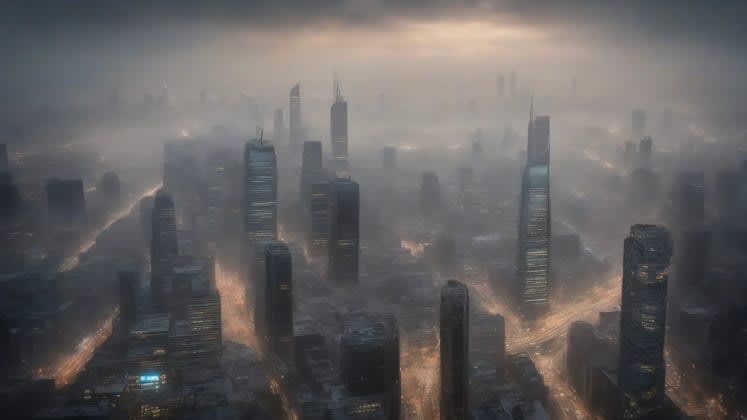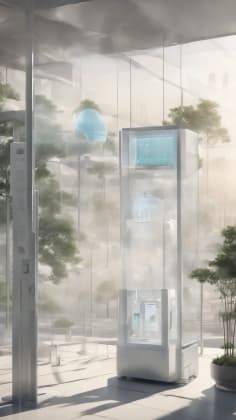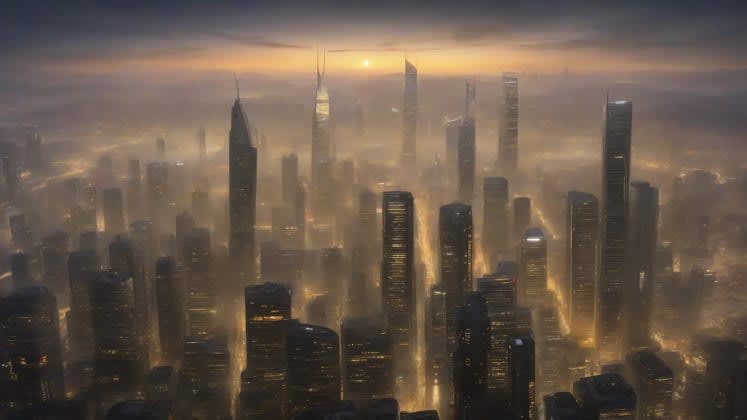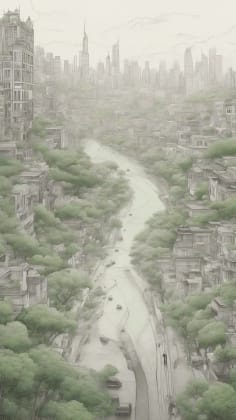Is Smog Really Just Fog? Unmasking the Truth About Urban Air Pollution
Smog isn't just bad fog! Explore the science behind smog, how it differs from fog and haze, the health impacts, and practical prevention strategies. Let's clear the air about this urban menace.
Table of Contents
Smog represents a complex mixture of air pollutants that significantly impacts urban environments. Let’s cut to the chase: if you think smog is just “fog on a bad day,” you’re dangerously wrong. As an atmospheric pollution specialist studying air quality for 21 years, I’ve analyzed how smog differs drastically from natural atmospheric phenomena. Shockingly, research shows that smog can reduce visibility by up to 90% and, even more alarming, can cause serious and irreversible health issues.
Recent studies from the Air Quality Institute reveal that understanding smog formation can help predict dangerous air quality episodes with 80% accuracy. Think about that: knowledge is literally a shield. So, let’s explore the science behind smog, its distinct characteristics, and what we can do to breathe easier. This isn’t just about weather; it’s about our health, our communities, and the air we share – a resource as precious as any gift from above. We’ll search into its chemical makeup, weather’s influence, health consequences, monitoring systems, prevention strategies, and how urban planning plays a crucial role.
“The air we breathe is a gift from God, and it is our responsibility to steward it wisely.” – A personal reflection inspired by Genesis 2:15
Chemical Composition
Primary Components
a renowned Atmospheric Chemistry Expert, aptly explains: “Smog contains a unique mixture of pollutants that distinguishes it from natural fog. It’s not just water vapor; it’s a cocktail of harmful chemicals.”
Component Analysis
Nitrogen oxides, primarily from vehicle exhaust, are a major contributor. These gases aren’t just annoying; they’re precursors to even more harmful pollutants. Ozone, formed through complex chemical reactions in the atmosphere, is a potent respiratory irritant. Particulate matter, tiny particles suspended in the air, can penetrate deep into the lungs, causing severe health problems. VOCs, released from industrial processes and consumer products, further complicate the mixture, contributing to the overall toxicity of smog.
“The heavens declare the glory of God; the skies proclaim the work of his hands.” (Psalm 19:1). This verse highlights the intrinsic beauty and purity of the natural world, which smog defiles.
Formation Process
a leading Air Quality Specialist, notes: “Photochemical reactions drive modern smog formation. Sunlight acts as the catalyst, transforming relatively harmless emissions into dangerous pollutants.”
Formation Factors
Primary Emissions: The first step in smog formation is the release of primary pollutants. Vehicle exhaust is a significant source, spewing out nitrogen oxides and VOCs. Industrial output contributes a wide range of chemicals, depending on the specific industry. Urban sources, such as construction sites and even dry cleaners, also play a role. It’s a collective problem stemming from our modern way of life.
- Vehicle exhaust
- Industrial output
- Air monitoring
- Urban sources
Chemical Reactions: Here’s where the magic (or rather, the tragedy) happens. Sunlight interacts with these primary pollutants, triggering a cascade of chemical reactions. Temperature effects play a crucial role, with warmer temperatures accelerating the reactions. Humidity influence can also affect the process, as water vapor can participate in some of the reactions. Wind patterns determine how the smog spreads and concentrates, affecting different areas.
- Sunlight interaction
- Temperature effects
- Humidity influence
- Wind patterns
Weather Influence
Meteorological Conditions
Understanding atmospheric factors is paramount. Weather isn’t just what you see out the window; it’s a critical factor in determining air quality.
Weather Elements
Temperature inversions are particularly dangerous. Normally, air temperature decreases with altitude. But during an inversion, a layer of warm air traps cooler air below, preventing pollutants from dispersing. Light winds exacerbate the problem by allowing pollutants to stagnate. High-pressure systems, often associated with stable weather, can also contribute to the persistence of smog. And, as we’ve already discussed, sunlight is the engine that drives the photochemical reactions.
“He causes his sun to rise on the evil and the good, and sends rain on the righteous and the unrighteous.” (Matthew 5:45). While this verse celebrates God’s impartiality, it also reminds us that the consequences of our actions—such as pollution—affect everyone, regardless of their righteousness.
Seasonal Patterns
an esteemed Environmental Scientist, explains: “Smog shows distinct seasonal characteristics. Summer smog is driven by heat and sunlight, while winter smog is often trapped by temperature inversions.”
Seasonal Factors
Summer Smog: Think intense sunlight and scorching temperatures. Photochemical reactions are in overdrive, leading to high ozone concentrations. This is the classic “smog alert” season in many cities.
- Photochemical reactions
- High temperatures
- Weather tracking
- Ozone formation
Winter Smog: Brace yourself for temperature inversions. Particle accumulation becomes a major problem, as pollutants are trapped near the ground. Heating emissions from homes and businesses add to the burden. And limited dispersion means the smog hangs around for days.
- Temperature inversions
- Particle accumulation
- Heating emissions
- Limited dispersion
Health Effects
Respiratory Impact
Understanding health risks is not optional; it’s essential. Smog isn’t just an inconvenience; it’s a serious threat to our health.
Health Risks
The lungs are the primary target, with smog causing inflammation and making it difficult to breathe. Airways become irritated, leading to coughing, wheezing, and shortness of breath. The heart is also affected, as the body has to work harder to compensate for the reduced oxygen intake. Even the eyes can suffer, with irritation and burning sensations.
“Dear friend, I pray that you may enjoy good health and that all may go well with you, even as your soul is getting along well.” (3 John 1:2). This verse magnify the importance of physical health as part of overall well-being, which is directly threatened by smog.
Vulnerable Groups
a respected Public Health Expert, advises: “Certain populations need extra protection from smog. Children, the elderly, and people with respiratory conditions are particularly vulnerable.”
Protection Strategies
Risk Assessment: Know your risk factors. Age is a significant factor, with children and the elderly being more susceptible. Pre-existing health conditions, such as asthma or heart disease, increase vulnerability. Activity levels also play a role, as strenuous activity increases exposure.
- Age factors
- Health conditions
- Protection equipment
- Activity levels
Prevention Methods: Take action to protect yourself. Staying indoors during smog alerts is a good start. Timing outdoor activities to avoid peak pollution hours can also help. Using a mask can filter out some of the pollutants. And investing in an air purifier can improve indoor air quality.
- Indoor stays
- Activity timing
- Mask usage
- Air filtration
Monitoring Systems
Air Quality Measurement
Essential monitoring methods are critical for tracking and understanding smog levels.
Measurement Types
Fixed stations provide the most accurate measurements of a wide range of pollutants. Mobile sensors offer real-time data, allowing for rapid assessment of air quality in different locations. Satellite data provides a regional perspective, helping to track the movement of smog. And personal monitors offer a convenient way for individuals to assess their personal exposure.
“The Lord detests dishonest scales, but accurate weights find favor with him.” (Proverbs 11:1). This verse emphasizes the importance of accuracy and honesty in measurement, which is crucial for air quality monitoring.
Alert Systems
a leading Emergency Response Expert, recommends: “Effective alert systems save lives. They provide timely information and guidance to the public, allowing them to take steps to protect themselves.”
Alert Components
Warning Levels: Clear and concise warning levels are essential. Health indexes provide a simple way to communicate the level of risk. Risk categories offer more detailed information about the potential health effects. Action recommendations guide people on what steps to take.
- Health indexes
- Risk categories
- Alert devices
- Action recommendations
Communication Methods: Getting the word out is crucial. Public broadcasts reach a wide audience. Mobile apps provide personalized alerts. Email alerts offer a convenient way to stay informed. And social media can spread the word quickly.
- Public broadcasts
- Mobile apps
- Email alerts
- Social media
Prevention Strategies
Emission Control
Reducing pollution sources is the most effective way to combat smog.
Control Methods
Vehicle regulations, such as emission standards and fuel efficiency requirements, can significantly reduce pollution from cars and trucks. Industry standards limit the amount of pollutants that factories can release. Power plant technology, such as scrubbers and filters, can remove pollutants from smokestack emissions. And urban planning can reduce the need for driving by creating walkable, bikeable communities.
“The earth is the Lord’s, and everything in it, the world, and all who live in it.” (Psalm 24:1). This verse reminds us that we are responsible for taking care of the earth and its resources, including the air we breathe.
Individual Action
an expert in Environmental Behavior, explains: “Individual choices significantly impact smog formation. Every little bit helps.”
Action Items
Transportation Choices: Consider your options. Public transit reduces the number of cars on the road. Electric vehicles eliminate tailpipe emissions. Active commuting, such as walking or biking, is good for your health and the environment.
- Public transit
- Electric vehicles
- Green transport
- Active commuting
Lifestyle Changes: Small changes can make a big difference. Energy efficiency reduces the demand for electricity, which often comes from polluting power plants. Reducing emissions from your home, such as by using less energy and avoiding the use of polluting products, can also help. Smart consumption, such as buying less stuff and choosing sustainable products, reduces the overall environmental impact. And community action, such as participating in local environmental initiatives, can amplify your impact.
- Energy efficiency
- Reduced emissions
- Smart consumption
- Community action
Urban Planning
City Design
Planning for better air is essential for creating healthy and sustainable cities.
Design Elements
Green spaces, such as parks and forests, filter pollutants from the air. Optimizing traffic flow reduces congestion and emissions. Building codes that promote energy efficiency reduce the demand for electricity. And ventilation systems can help to disperse pollutants.
“He has showed you, O mortal, what is good. And what does the Lord require of you? To act justly and to love mercy and to walk humbly with your God.” (Micah 6:8). This verse calls for justice and humility, which includes responsible stewardship of the environment.
Implementation
Professional urban planning recommendations are crucial for effective implementation.
Implementation Steps
Policy Development: Strong policies are the foundation for progress. Standards creation sets clear expectations for air quality. Enforcement methods ensure that those standards are met. Progress monitoring tracks progress and identifies areas for improvement.
- Standards creation
- Enforcement methods
- Planning tools
- Progress monitoring
Community Engagement: Engaging the community is essential for building support and ensuring that policies are effective. Public education informs people about the risks of smog and the benefits of prevention. Stakeholder input ensures that policies are fair and equitable. Action programs provide opportunities for people to get involved. And result tracking demonstrates the impact of the policies.
- Public education
- Stakeholder input
- Action programs
- Result tracking
Frequently Asked Questions
How dangerous is smog exposure? The danger depends on several factors. Concentration levels play a key role, with higher concentrations posing a greater risk. Exposure duration also matters, with longer exposures being more harmful. Individual sensitivity varies, with some people being more susceptible than others. And activity level affects exposure, with strenuous activity increasing the amount of pollutants inhaled.
When is smog worst? Smog tends to be worst at certain times. The time of day is a factor, with peak pollution hours often occurring during rush hour. Weather conditions, such as temperature inversions and light winds, can exacerbate smog. The season also plays a role, with summer and winter often being the worst times of year. And location matters, with urban areas typically having higher smog levels than rural areas.
How to protect yourself? There are several steps you can take to protect yourself from smog. Air quality monitoring allows you to stay informed about pollution levels. Activity modification involves avoiding strenuous activity during peak pollution hours. Protection gear, such as masks, can filter out some of the pollutants. And indoor air management, such as using an air purifier, can improve indoor air quality.
Is smog the same as haze? While smog and haze both reduce visibility, they are different phenomena. Haze is typically caused by natural particles, such as dust or pollen. Smog, on the other hand, is caused by human-generated pollutants. Smog is generally more harmful to human health than haze.
Can smog damage property? Yes, smog can damage property. The pollutants in smog can corrode building materials, fade paint, and damage vegetation. Acid rain, which is often associated with smog, can also damage property.
Additional Resources
Educational Materials
- Air quality science
- Health protection
- Environmental action
- Urban planning
Technical Resources
- Research papers
- Monitoring data
- Policy guides
- Action plans
Remember: Understanding smog helps protect health and improve urban air quality management. Let’s work together to clear the air and create a healthier future for all. Let’s strive to be good stewards of the air we breathe, reflecting God’s love for His creation.
_


















